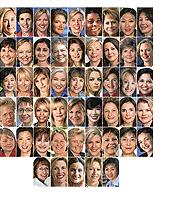 Wall Street Journal released its 2007 list of 50 women in business to watch. The list includes women from a variety of industries, which is great to see, but what I also found interesting was an article on the Wall Street Journal Online that provides an excerpt of an interview moderated by Wall Street Journal’s senior editor, Carol Hymowitz, and six women executives including:
Wall Street Journal released its 2007 list of 50 women in business to watch. The list includes women from a variety of industries, which is great to see, but what I also found interesting was an article on the Wall Street Journal Online that provides an excerpt of an interview moderated by Wall Street Journal’s senior editor, Carol Hymowitz, and six women executives including:
- Angela Braly, President and CEO, WellPoint Inc. (ranked #1 on WSJ list of 50 women to watch)
- Mary Sammons, Chairman and CEO of Rite-Aid Corp. (ranked #11 on WSJ list of 50 women to watch)
- Sheryl Sandberg, Vice President Global Online Sales and Operations of Google Inc. (ranked #19 on WSJ list of 50 women to watch)
- Melanie Healey, Group President Feminine and Health Care, Procter & Gamble Co. (ranked #30 on WSJ list of 50 women to watch)
- Michele Coleman Mayes, Senior Vice President and General Counsel, The Allstate Corporation
- Billie Williamson, Americas Director of Gender Equity and Flexibility, Ernst & Young LLP
The women were very candid during the interview on topics as diverse as work-life balance to the importance of mentors. Following are a few responses that stood out to me related to women in business:
WSJ: Does stereotyping still hold women back?
Michele Mayes: Women are put into this box that I call the four-H club. What the four H’s stand for are a woman’s hair, hips, hemline and husband. You rarely hear any of these for a man — and of course you expect his wife to be at home. So there’s this unconscious bias stuff swimming around when people are interviewing others for positions. They think to themselves, “This woman can’t travel,” or “She’s married, she’s not going to want to move,” or “She’s going to want to have kids so therefore won’t be available.” The only way you get around the stereotypes is to make sure people get to know you and what you want.
Sheryl Sandberg: There’s a Harvard Business School case about a woman named Heidi Roizen, who moved to Silicon Valley and used her interpersonal relationships to become a very successful venture capitalist. A business professor at Stanford last year took that case and changed the name to Howard. So then she had two cases, the Howard Roizen and the Heidi Roizen case and polled her students. When she asked, “Is this person competent?” Heidi and Howard came out even. Historically, I believe that is new, a huge step forward from 15 and certainly 30 years ago. But when the professor asked, “Do you want to work with this person and do you like this person?” Howard did a lot better than Heidi, who was seen as out for herself and too aggressive. So there’s still some room to improve how people see women who are working hard at their careers versus men. I’ve become more attuned to this.
WSJ: In companies you’ve worked in where men were the majority of managers, was there a lot of informal male networking on the golf course or after work that women were excluded from?
Mary Sammons: Those networks are still there. There’s a positive side for women: You can stay at work, get good results and while the men are still playing golf, you’re running the company. But it’s unfortunate to me that male networks are still so prevalent. I think it shows up on a lot of boards. So the question comes up: Do you actively go out and look for women for your board? I know I did.
Click the link to view the entire Wall Street Journal report of the 50 Women to Watch 2007.
Photo courtesy of Wall Street Journal Online




